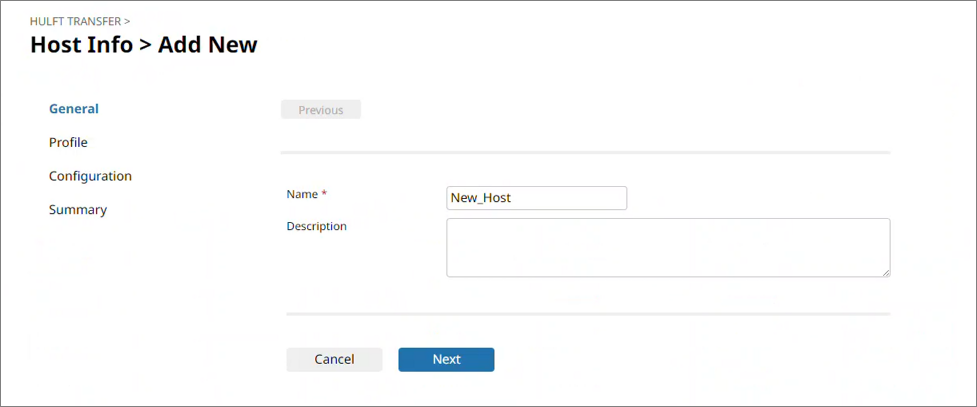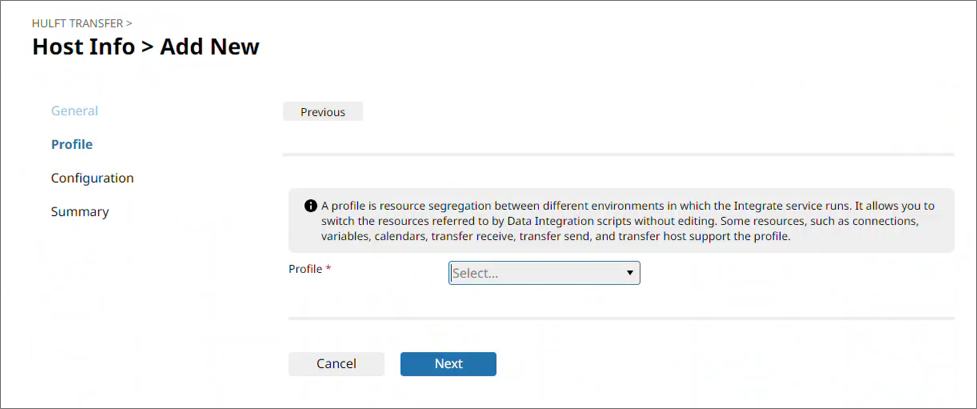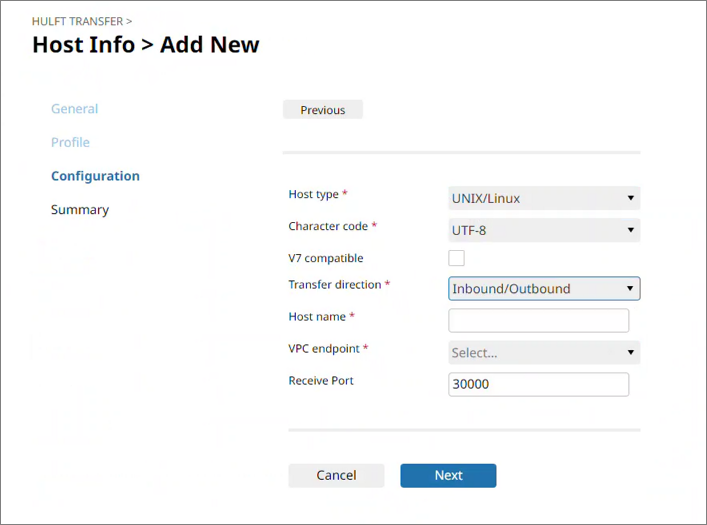Host Info
When you use the HULFT Transfer service, set the detailed information about the remote host for the file transfer (Host Info).
When you send files from HULFT Square, the information about the remote host refers to the receiving-side host information. When you receive files on HULFT Square, the information about the remote host refers to the sending-side host information.
When you use the HULFT Transfer service, be sure to set the HULFT Transfer Host configurations according to the functions and operations that you are using.
Users can specify workspaces in HULFT Transfer Host configurations to share with other users or groups.
For more details about how to use workspaces to share settings, refer to Share settings with team members.
This section explains the key points about setting the HULFT Transfer Host configurations.
Tutorials
For the entire operational flow of HULFT Square, including the setting procedures for the HULFT Transfer Host configurations, refer to the following tutorials:
Points for setting the HULFT Transfer Host configurations
This section explains the key points about setting the HULFT Transfer Host configurations on each settings page.
For the names and functions of the basic UI elements and other items of HULFT Square, refer to the following topic:
Host Info
To open this page, select  > HULFT TRANSFER > Host Info in the navigation menu.
> HULFT TRANSFER > Host Info in the navigation menu.
You can create and set up a new HULFT Transfer Host configuration or update the information that is already set.

- (1) Add
-
Select this icon to create a new HULFT Transfer Host configuration.
For the screen displayed after selecting this icon, refer to Host Info > Add New.
- (2) List of settings
-
The HULFT Transfer Host configurations that are already created are displayed in tabular form.
For details on each field, refer to the explanation on the Host Info > Add New.
- (3) Action menu
-
Select this icon to perform an operation for a HULFT Transfer Host configuration that is already created.
Selecting
 shows the menu of operations below.
shows the menu of operations below.- Information
-
The selected HULFT Transfer Host configuration is displayed. You can also edit and delete the HULFT Transfer Host configuration.
When you select this menu item, Host Info > Transfer Host configuration name is opened.
- Delete
-
Deletes the selected HULFT Transfer Host configuration.
NoteIn the following cases, you can't delete the selected HULFT Transfer Host configuration:
-
The specification of Host name in the selected HULFT Transfer Host configuration is used for Sender(s) in the HULFT Transfer Receive configuration
-
The specification of Host name in the selected HULFT Transfer Host configuration is used for Receiver in the HULFT Transfer Send configuration
-
To open this page, select Add on the Host Info page.
You can set the information to create a HULFT Transfer Host configuration by following the wizard-style pages step by step.
Step General

- Name
-
Specify the name of the HULFT Transfer Host configuration that you create.
- Description
-
Specify comments to explain the host that you set.
- Next
-
Displays the next page.
Step Profile

- Profile
-
Select a profile to link with the HULFT Transfer Host configuration.
- Next
-
Displays the next page.
Step Configuration

- Host type
-
Select the type of OS for the host that is specified in Host name.
NoteWhen the host type of the remote host is Windows and the character code for the transfer is UTF-8 or GB18030, specify Windows NT for Host type.
- Character code
-
Select the character code for the host that is specified in Host name.
- V7 compatible
-
The communication method for the host that is specified in Host name.
Select the checkbox if you want to connect with the HULFT7 communication mode even when the remote host is HULFT8.
- Transfer direction
-
Specify the direction to transfer files.
- Inbound
-
HULFT Square receives files from the remote host.
- Outbound
-
HULFT Square sends files to the remote host.
- Inbound/Outbound
-
HULFT Square receives files from the remote host and sends files to the remote host.
- Host name
-
When Inbound or Inbound/Outbound is specified for Transfer direction, specify Host name of the remote host.
When Outbound is specified for Transfer direction, specify Hostname on the HULFT Transfer service. For the specification of Hostname on the HULFT Transfer service, refer to SERVICES > HULFT Transfer.
NoteSpecify the correct host name that is registered on the remote host. The host name is case-sensitive.
- VPC endpoint
-
Specify this when Outbound or Inbound/Outbound is specified for Transfer direction.
Select a VPC endpoint on HULFT Square for HULFT Square to connect to your AWS environment (VPC).
For the settings for VPC endpoints, refer to SETTINGS > VPC Endpoint.
- Receive Port
-
When Outbound or Inbound/Outbound is specified for Transfer direction, specify the port number of the remote host.
- Next
-
Displays the next page.
Host Info > Transfer Host configuration name
To open this page, select Information from the action menu in the list of settings on the Host Info page.
The detailed information of the selected host is displayed. You can also edit or delete the information, or change the ownership.
By selecting Change ownership, you can change the ownership of the selected Host configuration to another member. When you change the owner, the value of Author changes.
In order to change the ownership, in addition to permission to view the Host configuration, you need the permission ChangeOwnership.
In Profiles, you can set the Host configuration for each profile.
If information has been set on the profile, Clear is displayed, allowing you to clear the setting information. If information hasn’t been set on the profile, Copy Configuration From is displayed, allowing you to copy setting information from another profile that has already been set and use it for that profile. However, information that differs depending on the profile, such as the host name, isn’t copied.
In the following cases, you can't delete the selected HULFT Transfer Host configuration:
-
In Host name of the selected HULFT Transfer Host configuration, Sender(s) for the HULFT Transfer Receive configuration is specified
-
In Host name of the selected HULFT Transfer Host configuration, Receiver for the HULFT Transfer Send configuration is specified